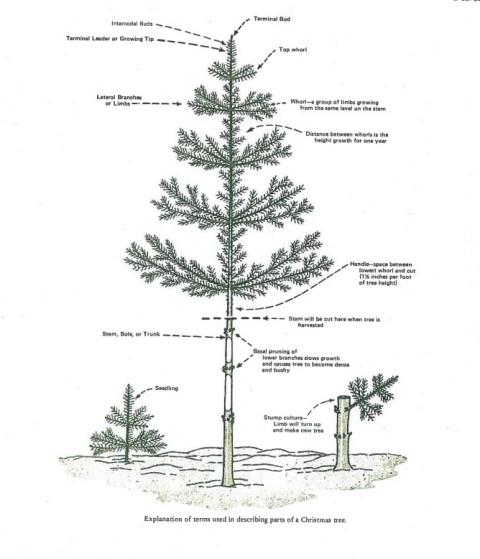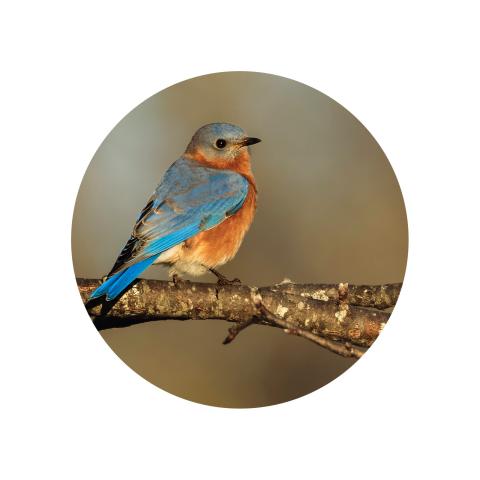Pruning and shearing produce the symmetrical, high-density, cone-shaped characteristics of a quality Christmas tree. The base of the live crown of the tree should be about two-thirds as wide as the height of the tree. An 8-foot tree should have a base width of about 5 feet. A well-shaped, dense tree has a fairly uniform spacing of 8 to 10 inches between whorls.
Although there are many schools of thought on how to shear or shape a Christmas tree, the basics of shaping are relatively the same. Proper and Timely shearing or clipping of branches stimulates new buds to form, puts additional growth on the remaining desirable branches and, in general, controls the foliage and shape so that a more dense tree results.
Terminal Leader Pruning
Excessive leader growth which detracts from the desired symmetry of the tree can be remedied through pruning of the terminal leader or basal pruning. In terminal leader pruning, the leader is cut back to the desired length, usually 8 to 12 inches. The cut should be made at an angle. It should be about 1 inch above a good bud. All buds below the top bud next to the cut should be removed from the leader down to about 3 inches from the top whorl. This will help prevent the formation of a multiple top. The top whorl of branches should be folded up alongside the leader to determine how much to shear. The lateral branches of the top whorl should be cut back so they are two-thirds the height of the pruned leader. This prevents one or more of the top whorl branches from taking over as a leader and forming a crooked or multiple top.
Basal Pruning
Basal pruning is accomplished by cutting of all branches from the ground up to a full, complete whorl of branches. Basal pruning, in addition to controlling excessive leader growth, will establish a good base or bottom whorl from which to develop a balanced tree and a clear handle or butt. Depending on the extent of basal pruning, the tree tries to replace the lost foliage by increasing the density of the remaining branches. Usually, as much as one-half of the live branches can be removed by basal pruning without killing the tree. Some growers, by using a combination of basal pruning and tip pruning, are able to achieve excellent results.
Lateral branch shearing
If the tree is not full enough, shearing of the lateral branches may increase the density of the tree.
Shearing is used to increase tree density and maintain the proper shape until harvest. It is usually started when at tree is 4 to 5 feet high, although some shearing may be necessary at a younger age to control a gross defect. Shearing is usually started when trees are 4 to 5 feet high on spruce and fir and at 3 feet on pines.
Shearing and shaping can be done with hand clippers or shears or a specially-designed, long-bladed shearing knife. Attention should be given to maintaining the desired taper. In essence, shearing the tree is accomplished by visualizing an imaginary cone over the tree and cutting off all the branches that stick out beyond the cone.
Once shearing has been started, it must be done every year to maintain uniform density.
Usually, only the terminal twig on each lateral branch needs to be cut off in shearing. On pines, all terminal shoots on each lateral branch must be clipped to stimulate additional bud development. On spruce and fir it is not as essential to shear all lateral branches as they have a more desirable and natural growth.
Time to Shear
Spruce and fir can be sheared at almost any time of the year. However, the development of new buds will best be stimulated if shearing is done during late June and July when new growth is beginning to firm up. Shearing during extremely cold periods in winter should be avoided because of twig dieback on the cut branch.
Pines can be sheared to achieve good results only when the new needle growth is about two-thirds the size of the old needle length. This usually occurs from mid-June to mid-July.
Deformities in individual trees can usually be corrected by clipping and shearing, thereby improving the quality and saleability of the tree. For example, if a tree is lopsided, it can be brought back into balance by clipping the longest lateral branches on the heavy side of the tree. Corrective work may have to be done for two or more seasons before the tree is shaped properly and is saleable. Multiple tops should be corrected by removing all but the most vigorous leader.
Experience has shown that unless cultural work is done on a tree it will rarely be a Premium grade tree and will usually grade out to a low U.S. No. 1 or a U.S. No. 2 tree. Most trees which are improved will grade out to a U.S. No. 1 or U.S. Premium, according to the United States Standards for Grades of Christmas Trees.

by By Stanley W. Knowles, Extension Specialist, Forestry and R. Marshall Patmos, Cheshire County Extension Forester Published in cooperation with the Division of Forests and Lands, Dept. of Natural and Cultural Resources, state of New Hampshire.
